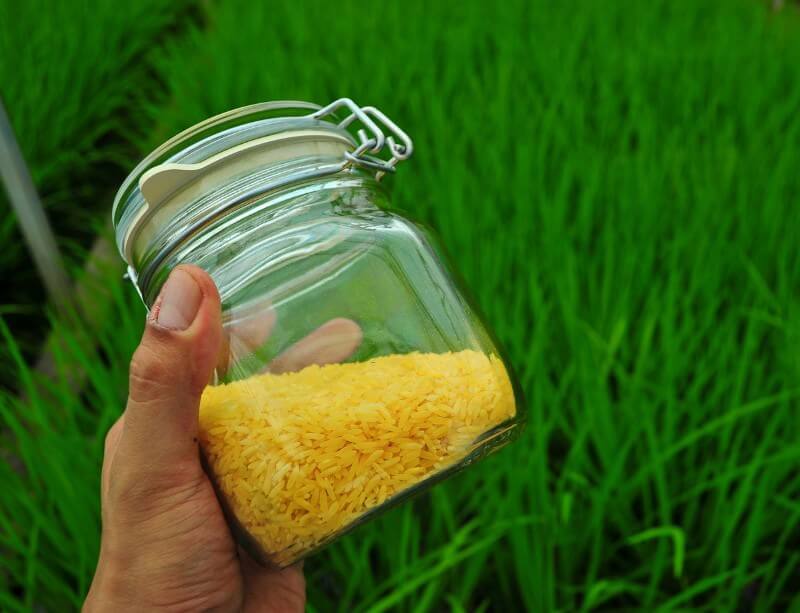Western scientists who introduce biotech crops into developing nations are paternalistic colonizers. While they claim to be helping farmers in poorer countries produce more nutritious food to feed the impoverished, the reality is that “GMO technology has not helped and has led to some objectionable consequences.” Golden Rice, which was engineered to combat vitamin A deficiency in southeast Asia, “comes in exchange for reliance on and control by Western entities …. When it comes to golden rice, questioning its impact and the motives behind it is not ‘anti-science,’ and it’s not up to GMO proponents to decide what’s best.”
This wasn’t the view of Greenpeace, which is known to promote anti-GMO conspiracies, but science writer Kavin Senapathy. Once a staunch  advocate for crop biotechnology — “I refuted piles of misinformation on GMOs in my writing,” she boasts — she has had a change of conscience about agricultural genetic engineering and the people who defend it. She outlined this transition in a recent piece in Slate titled Why I Stopped Defending GMOs.
advocate for crop biotechnology — “I refuted piles of misinformation on GMOs in my writing,” she boasts — she has had a change of conscience about agricultural genetic engineering and the people who defend it. She outlined this transition in a recent piece in Slate titled Why I Stopped Defending GMOs.
While she acknowledges there is no scientific evidence showing that biotech crops are harmful, Senapathy approaches the issue from an ideological perspective, framing Golden Rice — a project started more than two decades ago to reduce hunger and poverty in Asia using biotechnology, which scientists consider apolitical — as a partisan issue. This perspective misses the mark, as we’ll see, and will only fuel unjustified skepticism of science at a time when we badly need evidence-based thinking.
Examining the allegations
So why did Senapathy flip her views so dramatically? Her core argument is as follows:
- GE crops are promoted by “paternalistic” Western interests who “suppose that less developed countries simply need a little technological help from a society that knows more than they do.”
- GE crops aren’t as beneficial as their advocates claim.
- The political views of some key people in the “pro-GMO” camp are intolerable.
Senapathy traces her awakening to the 2016 presidential election, when she first realized that some supporters of crop biotechnology are conservatives, the implication being that only ideological liberals can support positive social change:
The 2016 general election is what began to make me question belonging to the pro-GMO community …. We had never really talked about politics, so it had been easy to assume that I’d been holding a picket sign next to people who’d oppose the presidential candidate refusing to make basic statements about believing in science and supporting social justice ….
But after the election it was clear from social media that some not only supported Trump—a blatantly racist, misogynistic candidate who flouts facts—but also taunted those of us who were upset about the victory in posts on social media …. As I stepped back from the movement a bit, I began to see its tactics as domineering, more eager to out argue the other side than have a dialogue that weighs all of the facts …. Little by little, I and others …. began to question being “pro-GMO.”
Monsanto’s decision to invite Canadian psychologist and self-help guru Jordan Peterson to the 2018 American Farm Bureau conference was “the last straw” for Senapathy. He spoke about how “farmers can prepare their children to go to college with the skills needed to push back effectively on bad ideologies,” Vance Crowe, the company’s former director of millennial engagement wrote at the time. But Senapathy saw an ulterior motive. “Monsanto’s objective seemed to be to equate an opposition to GMOs with a belief in Bigfoot,” she claimed.
Whatever one may think of Jordan Peterson (many on the right actually dismiss him as an unstable cult leader), his appearance at an American Farm Bureau Federation conference doesn’t support the contention that biotech advocacy has been compromised by right wingers. There are of course many conservatives who defend genetic engineering. But most working scientists have leaned to the left, according to PEW, and they overwhelmingly support biotechnology.
In 2015, when anti-GMO activism was at its height, a PEW poll of the American Association for the Advancement of Science (AAAS) found that 88% of all AAAS members believed that genetically engineered foods are safe — a higher percentage than the 87% who endorsed the belief that global warming is driven by humans. Moreover, most biotech companies are politically agnostic. Even Monsanto (now owned by Bayer) has expressed its “commitment to diversity and LGBT rights,” as GLP contributor Marc Brazeau noted recently.
 There are two major nonprofit organizations in the US dedicated to educating the public about crop biotechnology. Cornell University’s Alliance for Science, with its commitment “to achieving social justice, improving rural livelihoods and eliminating hunger,” is funded by the Gates Foundation and focuses on helping the developing world achieve food self-sufficiency.
There are two major nonprofit organizations in the US dedicated to educating the public about crop biotechnology. Cornell University’s Alliance for Science, with its commitment “to achieving social justice, improving rural livelihoods and eliminating hunger,” is funded by the Gates Foundation and focuses on helping the developing world achieve food self-sufficiency.
The GLP, where I am managing editor, is committed to “science without ideology.” It promotes biotech literacy and debunks disinformation, including the anti-GMO variety. Notably, GLP doesn’t hesitate to run articles calling out Republican politicians and media personalities when they stray from evidence-based policy making and advocacy (see here, here, here, here, here, here, here and here). It’s also given a platform to many left-leaning writers — including Kavin Senapathy, whose first articles on crop biotechnology were published on this site, and whose founder, Jon Entine, at her request, helped edit her co-authored book taking down the anti-biotechnology views of Vani Hari, “The Food Babe.”
While Senapathy found it “gut-wrenching” to discover that some of her pro-GMO compatriots were Republicans, diversity of opinion in the science community is important. The public approaches scientific issues with a wide variety of presuppositions. For example, anti-vaccine conservatives generally see campaigns to promote immunization as a government plot to eradicate our Constitutional rights, while liberal vaccine deniers, led by Hollywood celebrities and age-worn activists such as Robert F. Kennedy, Jr., have long linked vaccines to conspiracy theories about corporations deliberately harming people to line their pocketbooks. And anti-biotech liberals often view GMOs as a corporate conspiracy to take over the global food supply.

Perhaps the best way to convince all these skeptics that science doesn’t threaten their worldview is to have both conservative and liberal science communicators who can promote evidence-based thinking among their ideological allies. Senapathy’s frustration with this diversity of thought is precisely why the scientific community has had trouble convincing the public that crop biotechnology, when used appropriately, is a revolutionary force for positive change. For science advocates to build trust with the public, they need to do more than just cite facts and figures or raise an ideological flag. Political diversity in the science community should be seen as a feature, not a bug.
“Colonialism in science is still alive and well”?
While most scientists see crop biotechnology as a useful tool that can help improve food production and thus living standards in the developing world, Senapathy now views GE crops as a tool of Western colonialism, a perspective long espoused by the most marginal biotechnology deniers, such as the Organic Consumers Association:
Western entities that distribute GMOs abroad, like the Gates Foundation–funded African Agricultural Technology Foundation, have become embedded within governmental agencies throughout the continent. That gives these groups outsize influence in public policy.
Never mind that farmers all over the world have expressed their desire to cultivate biotech crops, and some growers will even break the law to acquire them. Also ignore the fact that scientists in the developing world have engineered biotech crops to help farmers in their native countries — such as in Bangladesh where insect-resistant Bt brinjal (eggplant) was distributed at little or no cost to poor farmers. Despite her claimed commitment to nuance, Senapathy portrays the biotechnology world in black and white, with the Gates Foundation as the icon of evil.
It’s certainly true that Gates and other wealthy foundations fund biotech crop research. But what nefarious “outsize influence” do they wield? Gates financed a polio vaccine program in Nigeria and a new anti-malaria drug so it could be sold to Africans at subsidized prices. The foundation also champions the use of birth control, “enabling women to make informed decisions about whether and when to have children.” Perhaps Senapathy believes the Gates Foundation is up to something, but whatever it is, she doesn’t elaborate.
For the record, many wealthy benefactors also finance a variety of farming practices in the developing world, including organic farming and agroecology, which (ironically) some African farmers and scientists have panned as “Green neo-colonialism” that puts poor people at greater risk of starvation.
The real story about Golden Rice
Perhaps the most egregious turn in Senapathy’s polemic is her attack on Golden Rice, which was engineered to fight vitamin A deficiency (VAD). Senapathy argued that it is a perfect example of the biotech industry bulldozing its way into the developing world, so let’s examine the facts. VAD afflicts roughly 250 million people, mostly preschool children in southeast Asia.
There have been attempts by numerous agencies over the past few decades, including the United Nations, to address the problem, but it persists. In 2016, despite existing interventions like vitamin supplementation, VAD killed 1.3–1.9 million people. Given those shocking statistics, Golden Rice, which will be offered at no increased cost to farmers once approved, is a monumental innovation. Senapathy isn’t impressed:
Suggesting that golden rice is a “gift,” ostensibly because it would be given free of charge to the poorest farmers, seems benevolent. But no one is putting out a pile of GMO seeds free for the taking and then just leaving the content alone. Farmers get the rice under a humanitarian license, which means there are strings attached.

But there are no strings. As Golden Rice Humanitarian Board member Adrian Dubock, who before retiring from Syngenta was instrumental in ensuring that Golden Rice wasn’t obstructed or held up by patent disputes, has explained:
Golden Rice seed, and regulatory data packages, are available – without cost – to public-sector rice-breeding institutions in less developed countries where rice is the staple and vitamin A deficiency endemic. Supply is subject only to national and inter – national regulations, and simple and free agreements. The licenses ensure that …. only publicly owned rice varieties can be used, and the nutritional trait cannot be ‘stacked’ with any other gmo-trait, unless the latter is also under the control of the public sector.
There will be no charge to growers or consumers for the nutritional trait: Golden Rice will cost the same as white rice …. All small-holder family farmers – responsible for 80% of global rice production – will eventually have access to it, with …. no limitations on planting or replanting, harvest, or sale of seed or grain.
These easy-to-verify details aside, what should be done to address VAD if Golden Rice is unnecessary, as Senapathy now believes? Citing anthropologist and well-known GMO skeptic Glenn Davis Stone, she argued “that the prevalence of VAD has dropped from 39 percent to 29 percent globally between 1991 and 2013, and from 40 percent to 15 percent between 2003 and 2008 in the Philippines. Quoting Stone she wrote:
‘GM crops played no role in this,’ he said. Studies suggest that these gains were achieved with vitamin supplementation, fortification of foods, nutritional education, and increasing the diversity of diets—and increasing access to those could help even more people. Too many proponents invested in GMOs like golden rice, either monetarily or emotionally, are ‘using the world’s poorest sickest little kids to sell it,’ he says. ‘Talk about crimes against humanity.’
Senapathy’s cherry picked statistics do not make her case. The effort to eradicate this scourge has stalled, particularly in countries across South Asia such as the Philippines where vitamin supplementation has made only a dent in the crisis and almost half of all children are susceptible to blindness and death, according to UNICEF. But with more than one million deaths caused by VAD in 2016 alone [new data are not available but experts say the situation has not improved in recent years], one wonders why GM crops shouldn’t play a role going forward. Why must anti-GMO activists — and despite her carefully worded piece, Senapathy has emboldened them — see biotechnology as an all-or-nothing choice? It’s one more tool, and a powerful one, with which to achieve sustainable farming goals and help developing countries reach food security.
And since Golden Rice is a fortified food, which Stone generally approves of, Senapathy offers no compelling reason to exclude it from this list of interventions. In fact, Golden Rice would likely be superior to some of these alternatives. “Supplement programs have been tried, and of course they do some good,” science writer Ed Regis, author of Golden Rice: The Imperiled Birth of a GMO Superfood, told the GLP in 2019,
…. but the problem is that such programs require a substantial and permanent infrastructure. They require a supply chain, personnel to distribute the stuff, record keeping, and the like, plus sufficient and continuous funding to keep it all going across time. Also, there is no way to guarantee that supplements will reach every last person who needs them. Golden Rice, by contrast, requires none of that.
Because of the limitations of supplements, at least 129 Nobel Laureates have co-signed a declaration sharply criticizing Greenpeace for promoting the very conspiracy propaganda and attack on vitamin A enhanced Golden Rice and GMOs in general that Stone endorses and Senapathy dismisses in her diatribe. According to Sir Richard J. Roberts, who launched the Nobel Laureates campaign in 2016,
More than 800 million people suffer from hunger in the world. Using modern plant breeding methods to generate so-called GMOs (Genetically Modified Organisms), agricultural scientists have shown that crop yields and nutritional quality can be greatly improved. Many GMO varieties have been specifically developed with the aim of being resistant to pests, tolerant to drought and containing beneficial nutrients. This leads to a reduction in the use of insecticides in water and on land. If anything, the GMO varieties are safer than traditionally bred varieties because they are made in a very precise manner. However, the scientific evidence on this issue is being ignored by the Green Parties such as Greenpeace who continue to deny the science and mislead the public. [156] Nobel Laureates have joined in a campaign to convince the Green Parties and the public that they should support the use of GMOs, especially for the sake of the developing world.
She’s wrong
The strength of the case made by Roberts and his fellow laureates has not diminished; rather it’s only grown. Senapathy is now aligning herself with the fringiest of science deniers—the post-modernist ‘critical theory’ faction, which is the leftwing version of Trumpism. After the article appeared, Sir Roberts sent an email to Senapathy, searing in its understatement:
I was very disappointed to read your piece in Slate Why I Stopped Defending GMOs. There were quite a lot of factual misconceptions in that article and I fear you have been listening to a lot of wrong-headed people.
Senapathy is mistaken about her former allies, and her assertions and insinuations about Golden Rice are incorrect, grossly so. There is no corporate plot to lure poor countries into dependence on Western technology. There are, however, billions of people who want access to cutting-edge tools that can improve their quality of life, genetically engineered crops being among them, with vitamin-enhanced food at the top of the list.
Responding to the claim that crop biotechnology is just more “neocolonialism” perpetrated by white Europeans, Ugandan science writer and GLP contributor Uchechi Moses recently made this point in what has become one of the most-read GLP articles of the past year:
The truth is that African farmers need biotech crops to feed themselves and their neighbors, as climate change makes farming an increasingly difficult profession. Consumers desire GMO-derived products for their superior quality and greater nutritional content. The continent’s population is skyrocketing and incomes are rising, which fuels demand for a greater variety of foods. It is science, not conspiracy theories, that will allow Africa to meet these challenges.
As one science commentator wrote after Greenpeace and the anti-agricultural biotechnology activist Vandana Shiva attacked Golden Rice:
Tenuous accusations that the laureates were exploited demonstrate that anti-technology activists would rather throw tantrums than accept that GMO technologies are safe and beneficial. … It reeks of “let them eat cake.”
Who wrote that? Kavin Senapathy, in 2016, and it holds true today.
Cameron J. English is the GLP’s managing editor. Follow him on Twitter @camjenglish. Executive Director Jon Entine edited this commentary. Follow him on Twitter































